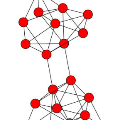Graph representation learning aims to effectively encode high-dimensional sparse graph-structured data into low-dimensional dense vectors, which is a fundamental task that has been widely studied in a range of fields, including machine learning and data mining. Classic graph embedding methods follow the basic idea that the embedding vectors of interconnected nodes in the graph can still maintain a relatively close distance, thereby preserving the structural information between the nodes in the graph. However, this is sub-optimal due to: (i) traditional methods have limited model capacity which limits the learning performance; (ii) existing techniques typically rely on unsupervised learning strategies and fail to couple with the latest learning paradigms; (iii) representation learning and downstream tasks are dependent on each other which should be jointly enhanced. With the remarkable success of deep learning, deep graph representation learning has shown great potential and advantages over shallow (traditional) methods, there exist a large number of deep graph representation learning techniques have been proposed in the past decade, especially graph neural networks. In this survey, we conduct a comprehensive survey on current deep graph representation learning algorithms by proposing a new taxonomy of existing state-of-the-art literature. Specifically, we systematically summarize the essential components of graph representation learning and categorize existing approaches by the ways of graph neural network architectures and the most recent advanced learning paradigms. Moreover, this survey also provides the practical and promising applications of deep graph representation learning. Last but not least, we state new perspectives and suggest challenging directions which deserve further investigations in the future.
翻译:图表示学习旨在将高维稀疏的图结构数据有效地编码成低维密集向量,是一项基础任务,已广泛研究在机器学习和数据挖掘等各个领域。传统的图嵌入方法遵循的基本思想是,图中相互连接的节点的嵌入向量仍然可以保持相对较近的距离,从而保留节点之间的结构信息。但是,这种方法存在以下缺陷:(i)传统方法的模型容量有限,限制了学习性能;(ii)现有技术通常依赖于无监督学习策略,无法与最新的学习范式配合;(iii)表示学习和下游任务互相依赖,应该共同增强。随着深度学习的显著成功,深度图表示学习显示出了巨大的潜力和优势,过去十年中已经提出了大量深度图表示学习技术,特别是图神经网络。在这篇综述中,我们通过提出现有最新文献的新分类法,系统地概括了当前深度图表示学习算法。具体而言,我们系统地总结了图表示学习的基本组成部分,并按照图神经网络的架构方式和最新的高级学习范式对现有方法进行分类。此外,该综述还提供了深度图表示学习的实际和有前途的应用。最后,我们提出了新的观点,并建议未来进行进一步研究的具有挑战性的方向。


